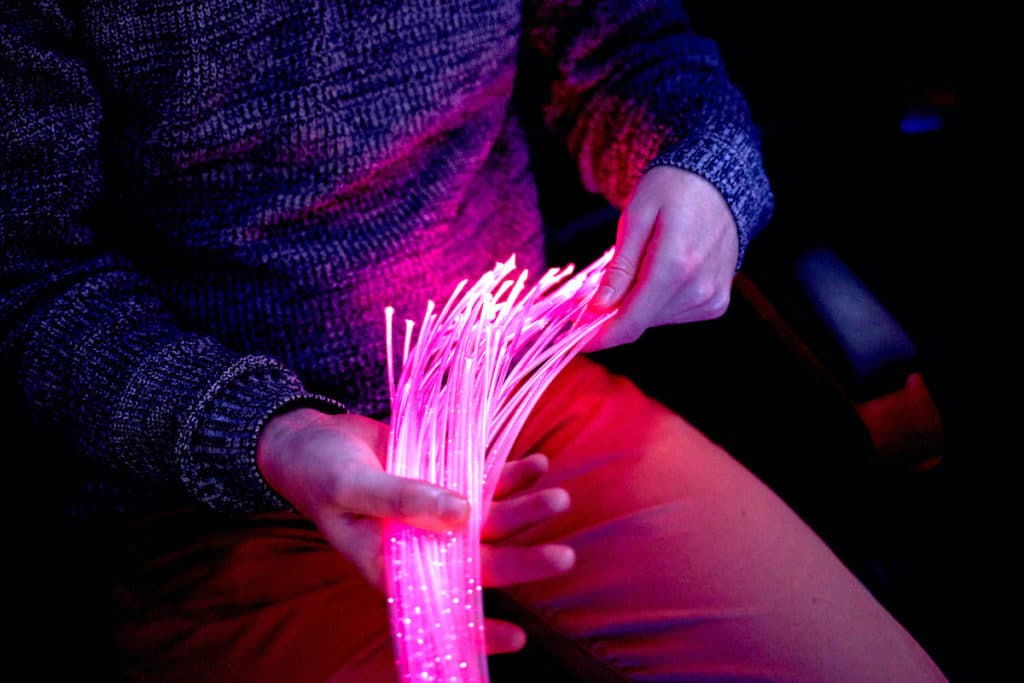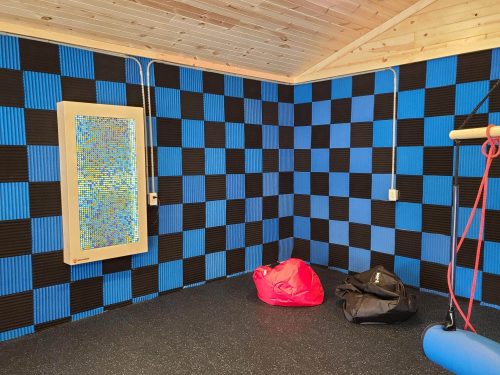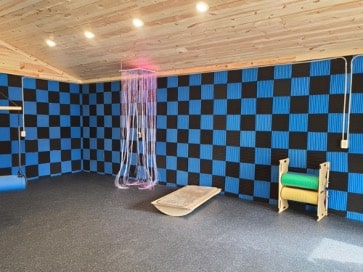Do you ever find yourself tapping your fingers on your desk when you’re bored or fidgeting with your hair or clothes when you feel nervous? These small physical movements can provide a sense of relief when you’re emotionally overwhelmed. Most people carry out these behaviors absentmindedly without considering their positive effects.

However, people with autism tend to display more visible stimulating acts, referred to as “stimming.”1 Stimming is one way these individuals can process the sensory overload that is a characteristic sign of autism. Sensory overload is caused by a dysfunctional sensory system, which people with autism manage through stimming behaviors like hand-flapping, rocking, or repetitive vocalization.
Sensory rooms are a crucial part of helping individuals with autism learn to manage sensory overload and work toward sensory integration. Many treatment programs for autism incorporate these rooms as part of a comprehensive treatment process. They help individuals work through their sensory struggles so they can function more effectively in their lives.
Not all programs offer these vital tools for sensory processing but their usefulness is impossible to deny. What are sensory rooms, how are they used to help, and what are some of the benefits of a sensory room for people with autism?
Understanding Human Senses
When you were young you likely learned about the five human senses: sight, hearing, touch, taste, and smell. The five main senses are the primary ways you interact with the world around you. And while they are an important part of your human experience, they don’t make up the whole picture.
You have a range of other senses that are far less familiar to most people. The limited awareness of these senses makes them no less important than your primary ones, though. They are crucial for your basic survival and ensure your effective functioning in daily life. Three of these additional senses include:
- Proprioception: Sense of the body in space and its relation to other objects
- Vestibular: Sense of balance and orientation in space
- Tactile: Sense of physical stimuli (i.e. light touch, pressure, pain, temperature)
Many people with autism struggle to process these three critical senses.2 When someone has difficulties interpreting these senses it typically causes troubles with processing their external environment. This may develop into problems with information processing, behavior regulation, and social development. Recognizing and working on these sensory difficulties is a primary goal when working with people who have autism.

What is a Sensory Room?
A sensory room is a room that is designed to provide sensory stimulation in a safe, controlled, and relaxing environment. It includes a wide variety of sensory stimulators that people can interact with through visual, tactile, and auditory experiences. Sensory rooms are beneficial for children and adults alike, but they are especially useful for individuals with autism.
Since many people who have autism struggle with a dysfunctional sensory system, sensory rooms are perfect environments. Traditional treatment spaces are often washed out by bright fluorescent lights and permeated by unpredictable noise. Sensory rooms are constructed intentionally to be devoid of these overwhelming stimulating factors.
Some of the sensory stimulators offered in these rooms include deep pressure rollers, swings, interactive wall panels, bean bag chairs, weighted blankets, balance beams, and more. People with autism can immerse themselves in these comforting experiences as a way to manage their usually overwhelmed sensory systems.
How Are Sensory Rooms Used?
Autism is not a singular experience. Each person with autism is unique and has their own troubles and difficulties, just like every other neurotypical individual. This means that treatment is not a one-size-fits-all solution, nor is the use of sensory rooms. Clinicians don’t simply place people in a sensory room without an end goal in mind. Every effective autism treatment program begins with a sensory assessment to determine the most useful approach.
As one of our clinicians here at Pasadena Village explained, sensory rooms are often surrounded by misconceptions. Since some people with autism struggle with physical contact, many believe that sensory rooms serve as a segue to human contact. In reality, the primary goal of sensory rooms is to encourage emotional regulation through sensory relief.
Additionally, sensory rooms are not used as a “time-out” or as a reactive measure for escalating behavior. They are used as a proactive tool to teach regulation skills so escalated behavior becomes less frequent and less disruptive. Skills learned while spending time in treatment sensory rooms are useful long after treatment ends. They help individuals build a sensory toolbox during treatment that is useful in daily life after completing their program.

Benefits of Sensory Rooms for People with Autism
While sensory rooms may be useful for everyone, they offer myriad benefits for people with autism in particular. Individuals on the spectrum will find that sensory rooms create a unique space where they can process their sensory struggles. Some of the benefits of sensory rooms for people with autism include:
- Stimulates the senses
- Encourages sensory integration
- Reduces stress
- Improves ability to focus
- Develops emotional regulation skills
- Encourages socialization
- Enhances creativity
- Provides mental and physical relaxation
Maintaining Sensory Integration After Treatment
Some clients find that a facility’s sensory room acts as a catalyst for maintainable emotional regulation. Others find that they may need continued sensory input after their time in treatment. In these cases, successful sensory integration requires ongoing work after leaving the treatment environment.
Thankfully, there are many easy and inexpensive ways to build a sensory room after leaving treatment. A helpful sensory room doesn’t require much space. You can easily create one in the corner of a room using soft surfaces, gentle lights, and a white noise machine. Bean bag chairs and weighted blankets are readily available. Tactile tools like Play-Doh or fidget toys can be found at most stores.
Part of the sensory integration process also includes shifting to more useful behaviors outside of treatment. For example, some individuals tap loudly on tables or other surfaces which may cause disruption. Teaching people to tap on other objects, such as their legs or a toy in their hands, may be more practical.
Ultimately, maintaining sensory integration after treatment is a case-by-case experience. Things that work for some individuals may not work for others. An effective treatment program must determine which skills are most helpful for each person they work with and equip them with these tools before finishing treatment.

Autism Treatment at Pasadena Villa
Pasadena Villa is a psychiatric treatment network that provides compassionate, comprehensive care to people who have difficulties navigating and functioning in their daily lives. We believe that everyone can live happy, healthy, whole lives when equipped with the right tools and surrounded by support.
Our Social Integration Model is a unique treatment strategy that helps our clients develop life skills and social interaction. The skills they learn during treatment bolster their abilities to engage with the world and interact with others around them. Sensory integration is a primary goal of treatment at Pasadena Villa and our Social Integration Model is designed to ensure each person’s success.
To learn more about autism treatment at Pasadena Villa, please reach out! Give us a call or submit an online request form to speak with our admissions team today. We will help you understand your options and determine which program is the best fit for you or your loved one. We look forward to speaking with you!



